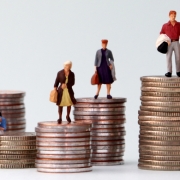Wages Are Growing And Inequality Is Narrowing. Don’t Expect To Hear Much About It.
With the Democratic presidential campaign under way, get ready to hear a lot about economic inequality. Sen. Elizabeth Warren, who’s surging in the polls, has complained about “a rigged system that props up the rich and the powerful and kicks dirt on everyone else.” In reality, the strongest economy in more than a decade is bringing benefits to everyday Americans.
According to an April study by the New York Federal Reserve, the average starting wage offer for full-time employees jumped from $58,035 in November to a series high of $66,415 in March. The average expected likelihood of receiving a job offer was also the highest recorded since the survey began in 2014—and the gain was “most pronounced for respondents without a college degree.”
The Bureau of Labor Statistics’ employment data have been reflecting significant income growth for working-class Americans for months. With more Americans working than at any time in history, the unemployment rate near a 50-year low, and 14 consecutive months with more job openings than unemployed people, for the first time in decades it’s harder to find blue-collar workers than white-collar ones. This competition for employees is driving wages up, which narrows income inequality.
Wages in May for nonsupervisory employees increased 3.4% year over year, the 10th consecutive month at or above 3%—after a stretch in which wage growth had been below 3% for every month since May 2009. The recent gains were even more significant for workers in traditional low-wage sectors. For retail workers, wages rose 3.8% in April, the 14th consecutive month at or above that rate (December’s 5.1% increase was the largest since 1998). For hotel and restaurant workers, the April increase was 4.7%, the eighth consecutive month at or above 4% (and March’s 4.7% increase was the largest since 2008).
Large employers are driving hourly wages closer to the Democrats’ $15 goal without a federal mandate. Within the past six months Costco and Amazon have raised their minimum wages to $15, and Target said that it will reach $15 by next year. In April Bank of America announced an increase to $17 an hour, and to $20 by 2021.
The minimum wage is bad policy, but prosperity renders it moot. With its starting wage already over $10 an hour and wages rising, even McDonald’s has withdrawn its opposition to a minimum-wage increase. Walmart ’s CEO recently went a step further and called for a minimum-wage increase. Walmart already pays an average wage of $17.50 an hour including benefits.
This trend will continue as employers compete for working-class employees—if the economy keeps growing. In a recent Wall Street Journal survey of economists, nearly 70% expected faster wage growth during the coming year.
Economic growth won’t eliminate all income inequality—and that’s good. Capitalist economies reward people for meeting the needs of others—their customers. Steve Jobs and Jeff Bezos didn’t get rich by stealing. They accumulated disproportionate wealth because they provided disproportionate benefit.
Meanwhile, politicians who say they want to alleviate income inequality overstate the problem. Sen. Bernie Sanders asserts that the income gap is “wider than at any time since the 1920s.” This claim is based on research by Emmanuel Saez, an economics professor at the University of California, Berkeley. But Mr. Saez ignores the impact of taxes on high earners. The top marginal income-tax rate in the late 1920s was 25%, vs. 37% today. Nor does he take account of welfare benefits. Food stamps, public housing, Medicaid and Social Security didn’t exist in the 1920s.
Under Mr. Saez’s analysis, liberal interventions—both increasing taxes on the wealthy or increasing benefits for the needy—are omitted from considerations of income inequality. Thus Mr. Sanders, Ms. Warren and others demand government action to stem what they claim is a long-term and rapidly worsening trend but fail to take into account the impact on inequality of the government actions they advocate.
A 2018 study by nonpartisan economists David Splinter (of Congress’s Joint Committee on Taxation) and Gerald Auten (of the Treasury’s Office of Tax Analysis) came to a far different conclusion. Messrs. Splinter and Auten used 1960 as the base year and used “measures of pretax and after-tax incomes” including government transfers. They found that while economists including Mr. Saez had determined that the top 1%’s share of income “increased by two-thirds since 1960,” the actual increase was “relatively modest” at “less than half a percentage point.”
No matter how you measure income inequality, the most effective way to reduce it is through policies that encourage job-creating, wage-increasing economic growth. Unlike government redistribution, economic growth creates the competition for employees that lifts working-class wages, and that’s what it’s doing today.
Mr. Puzder is a former CEO of CKE Restaurants and author of “The Capitalist Comeback: The Trump Boom and the Left’s Plot to Stop It.”




